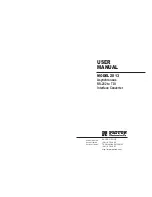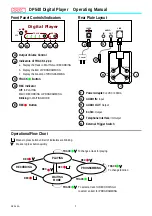
Using the Stack (PUSH/POP)
16-28
16.27 Using the Stack (PUSH/POP)
The stack, as with any processor, is an area of memory that can be used to store
information temporarily, including the return address for returning from subroutines
that are called by ACALL or LCALL. The 8052 automatically handles the stack
when making an ACALL or LCALL, as well as when returning with the RET instruc-
tion. The stack is also handled automatically when an ISR is triggered by an inter-
rupt, and when returning from the ISR with the RETI instruction.
Additionally, the stack can be used for your purposes and for temporary stor-
age by using the PUSH and POP instructions. The PUSH instruction puts a
value onto the stack, and the POP instruction takes off the last value put on
the stack. A value can be saved temporarily by PUSHing it onto the stack, and
that value may be restored by POPing it.
Note:
The stack operates on a last in first out (LIFO) basis. When PUSHing the val-
ues 4, 5, and 6 (in that order), POPing them one at a time will return 6, 5, and
then 4. The value most recently added to the stack is the first value that will
come off when executing a POP instruction.
An example using the PUSH and POP instructions is:
MOV A,#35h
;Load the accumulator with the value 35h
PUSH ACC
;Push accumulator onto stack, accumulator still holds 35h
ADD A,#40h
;Add 40h to the accumulator, accumulator now holds 75h
POP ACC
;Pop the accumulator from stack, accumulator holds
;35h again
The above code is functionally useless. However, it does illustrate how to use
PUSH and POP.
The code starts by assigning 35
H
to the accumulator. It then PUSHes it onto
the stack. Then it adds 40
H
to the accumulator, just to change the accumulator
to something else. At this point the accumulator holds 75
H
. Finally, it POPs
from the stack into the accumulator. The POP restores the value of the accu-
mulator to 35
H
because the last value pushed onto the stack was 35
H
.
Note:
When PUSHing or POPing the accumulator, it must be referred to as ACC
because that is the memory location of the SFR. The instructions PUSH A
and POP A cannot be assembled—both of these will result in an assemble-
time error in most, if not all, 8052 assemblers.
When using PUSH, the SFR or internal RAM address that follows the PUSH
instruction is the value that is PUSHed onto the stack. For example, PUSH
ACC pushes the value of the accumulator onto the stack. PUSH 60h pushes
the value of internal RAM address 60
H
onto the stack.
Likewise, the internal RAM address or SFR that follows a POP instruction indi-
cates where the value should be stored when it is POPed from the stack. For ex-
ample, POP ACC pops the next value off the stack and into the accumulator. POP
40h pops the next value off the stack and into internal RAM address 40
H
.
Содержание MSC1210
Страница 1: ... December 2002 User s Guide SBAU077 ...
Страница 149: ...Digital Filter 12 13 Analog to Digital Converter Figure 12 5 Filter Frequency Responses ...
Страница 162: ...12 26 ...
Страница 234: ...Timers 17 6 Figure 17 4 Timer Counter 1 Mode 1 Figure 17 5 Interrupt System ...
Страница 273: ...Serial Port I O 17 45 Keil Simulator Figure 17 19 Clock Control Peripheral Figure 17 20 USART0 Preipheral ...
Страница 282: ...C 4 ...
















































